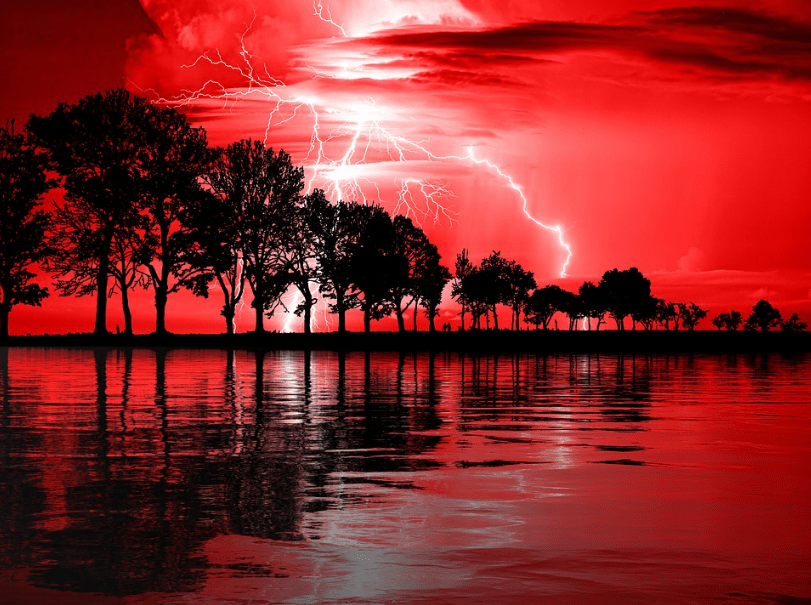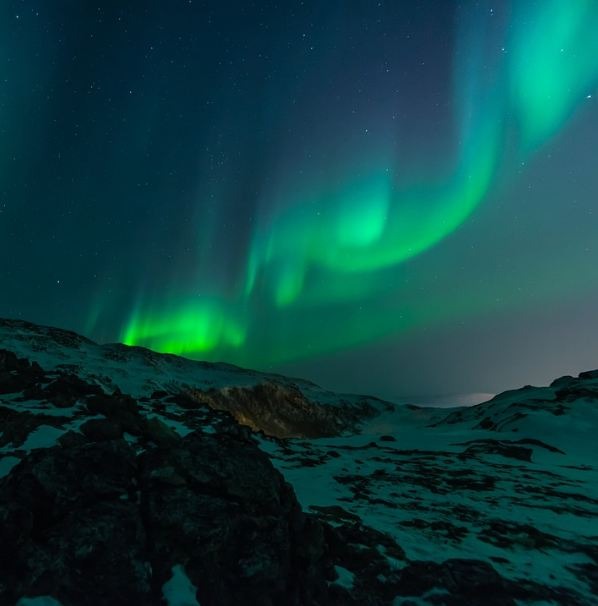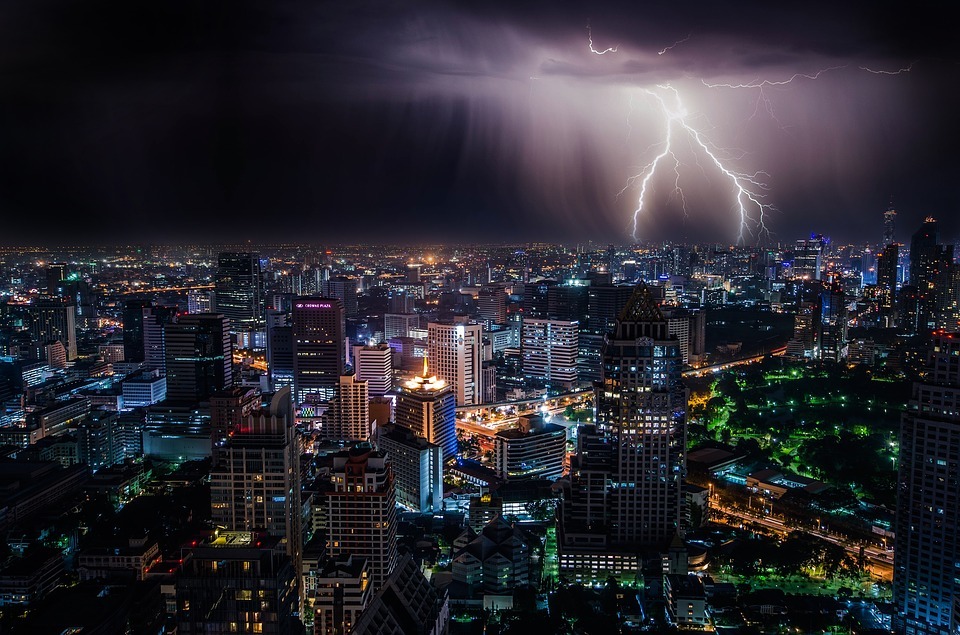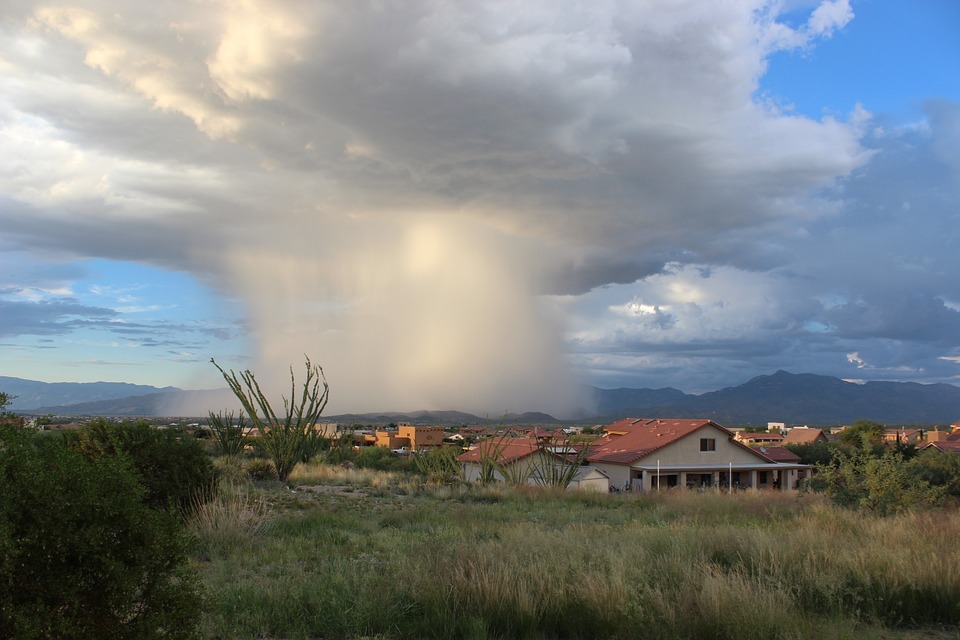What Causes Tornadoes in Calm Weather?
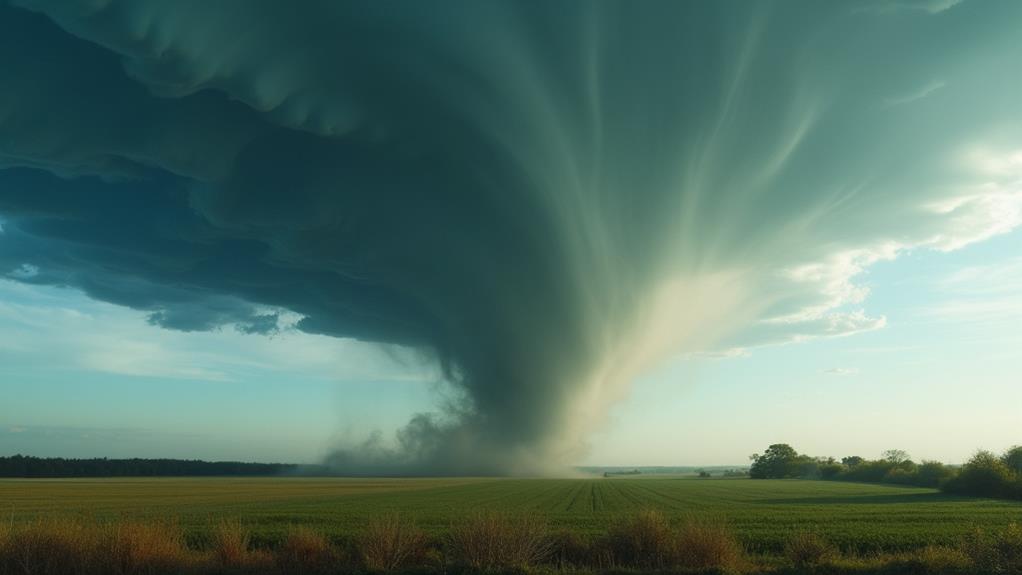
Tornadoes can form even during calm weather due to sudden changes in atmospheric instability and wind shear. When warm, moist air rises and meets cooler, dry air, it creates instability. Wind shear, which is the change in wind speed and direction with altitude, improves this effect by causing rotating updrafts known as mesocyclones. These powerful updrafts can lead to tornadoes even without severe thunderstorms present. So, if you're interested in understanding why tornadoes sometimes catch us by surprise, there's plenty more to uncover about how atmospheric conditions play a vital role.
Key Takeaways
- Wind shear can create rotating updrafts that lead to tornadoes even without severe thunderstorms.
- Minor atmospheric stability changes can trigger tornado formation in seemingly calm weather.
- Tornadoes can develop from mesocyclones formed by wind shear and updrafts in calm conditions.
- Historical records show tornadoes have occurred without significant atmospheric disturbances.
- Tornadoes can form without severe weather due to localized pockets of atmospheric instability.
Atmospheric Instability
Atmospheric instability plays a crucial role in tornado formation, even when the weather seems calm. It occurs when warm, moist air near the ground rises and cools, creating a conducive environment for thunderstorms. This unstable atmosphere is a breeding ground for tornadoes. When there's a significant temperature difference between the warm, moist air at the surface and the cooler, drier air above, the atmosphere becomes highly unstable. This temperature contrast fuels the rising and cooling air, which can lead to the development of severe thunderstorms.
Localized pockets of instability can emerge from variations in terrain or land use, contributing to the potential for tornado formation. Even in calm weather, these small-scale atmospheric disturbances can quickly escalate into severe conditions. The change can be abrupt, as minor changes in atmospheric conditions can rapidly lead to significant weather events, including tornadoes.
While atmospheric instability sets the stage, the presence of wind shear improves this instability, making tornado formation more likely. It's the combination of these factors—warm, moist air, significant temperature differences, and an unstable atmosphere—that can turn a seemingly calm day into one filled with severe thunderstorms and tornadoes.
Role of Wind Shear
In seemingly calm weather, wind shear plays a vital role in tornado formation. You might not realize it, but wind shear refers to changes in wind speed and direction with altitude. This phenomenon is a key ingredient for tornado formation, even when the weather appears tranquil.
When warm, moist air near the ground collides with cooler, dry air above, wind shear can create the instability needed for thunderstorms to develop. This interaction fosters conditions ripe for severe thunderstorms. The presence of strong wind shear can lead to rotating updrafts within these storms, known as mesocyclones, which are fundamental precursors to tornado formation.
Wind shear increases the likelihood of tornadoes by allowing rotating air currents to align vertically. This alignment transforms horizontal winds into vertical rotations, setting the stage for potential tornadoes. So, even if the weather seems calm, don't be fooled—significant wind shear can still create the perfect conditions for severe thunderstorms capable of producing tornadoes.
Understanding wind shear's role is important because it helps explain why tornadoes can develop unexpectedly. It's the hidden force that, when combined with other atmospheric factors, triggers the violent and unpredictable nature of tornadoes.
Importance of Updrafts
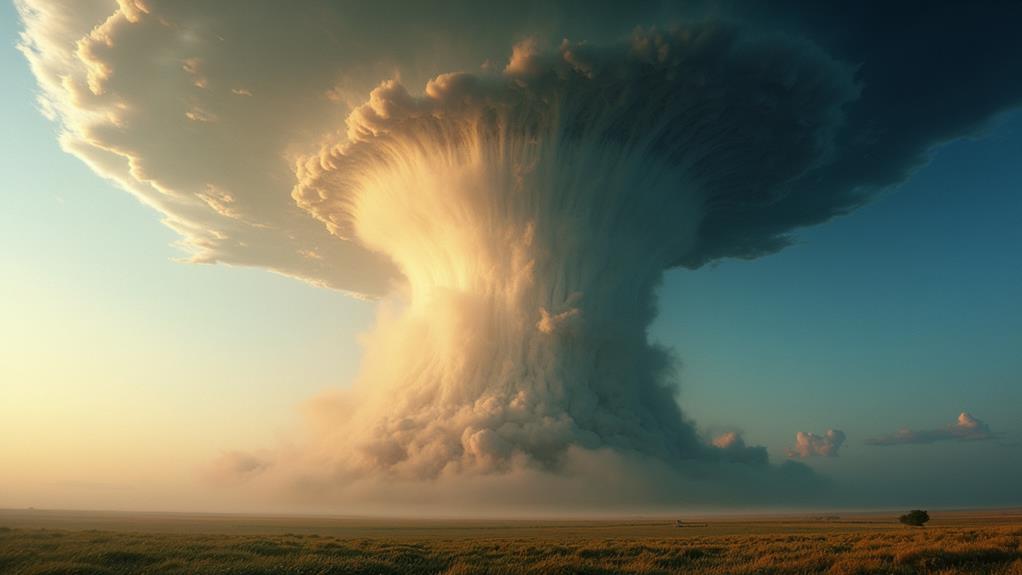
Updrafts play an important role in tornado formation by lifting warm, moist air to higher, cooler altitudes where it condenses and forms clouds. When you're observing the conditions that lead to tornadoes, updrafts are one of the initial elements to take into account. They create the instability needed in the atmosphere for tornado formation. In severe thunderstorms, especially supercells, updrafts can reach speeds of over 100 mph, providing the energy required for developing mesocyclones.
- Strong updrafts: These are vital in thunderstorms as they initiate the air's rotation.
- Wind shear: This improves updraft strength, facilitating the necessary rotation for tornado formation.
- Energy contribution: Updrafts fuel the development of tornadoes by lifting warm air.
- Calm weather dynamics: Even in seemingly calm conditions, considerable updrafts can lead to tornadoes.
Without these powerful updrafts, the likelihood of tornadoes forming diminishes greatly. They work hand-in-hand with wind shear to create the necessary rotation within a thunderstorm, ultimately leading to mesocyclones and tornado formation. Understanding updrafts gives you a clearer view of the complex processes behind these natural phenomena.
Mesocyclones and Supercells
Mesocyclones form when rotating updrafts within supercell thunderstorms create a powerful and organized system. You'll find that supercells are special types of thunderstorms known for their long-lived, organized structure. They're characterized by a persistent updraft that can sustain rotation for extended periods. This is the initial step toward tornado formation.
When warm, moist air rises into a thunderstorm, it encounters wind shear. Wind shear is a change in wind speed and direction at different altitudes. This interaction causes the updraft to start rotating, creating a mesocyclone—a rotating column of air. Mesocyclones are vital because they often precede tornadoes, given the right conditions.
Supercells don't just stop at mesocyclones; they're capable of producing severe weather phenomena like large hail and damaging winds. The strong updraft and downdraft interactions within supercells make them potent weather systems. In the United States, the majority of tornadoes come from these supercell thunderstorms. Their ability to generate intense and violent tornado activity is well-recognized.
Unexpected Tornado Conditions
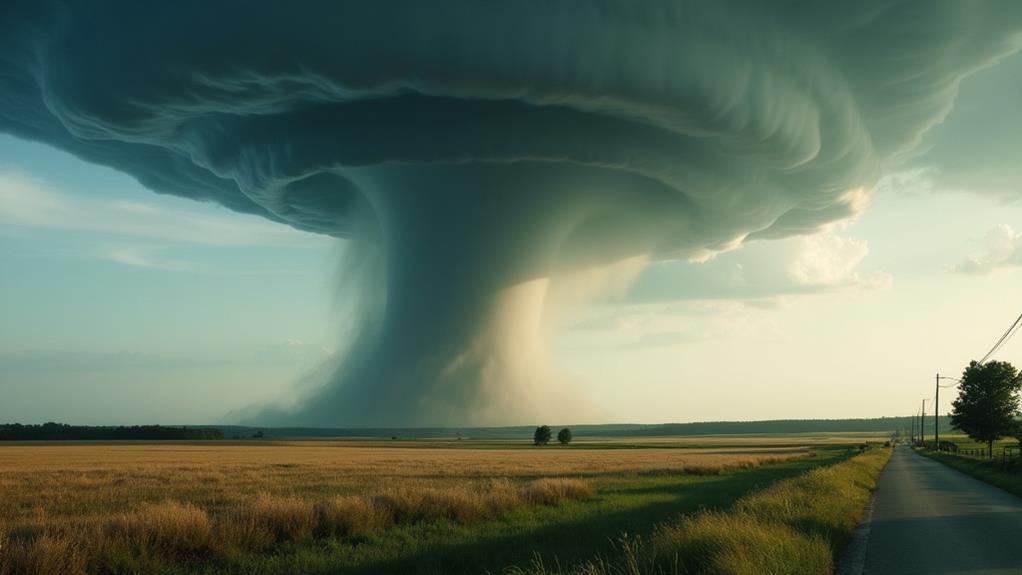
Surprisingly, tornadoes can develop even when the weather seems calm and uneventful. You might think that tornadoes require violent storms, but that's not always the case. Tornadoes can occur in calm weather given the right conditions. For instance, a sudden change in atmospheric stability, like localized heating or an arriving cold front, can upset the calm.
Key factors leading to unexpected tornado conditions include:
- Wind shear: Changes in wind speed and direction with height can create the necessary rotation for tornado development even when it seems calm.
- Mesocyclone: A rotating updraft within a thunderstorm can form in calm conditions and might lead to a tornado if other factors align.
- Subtle disturbances: Tornadoes have been documented without severe thunderstorms, showing that tornado development doesn't always need intense storms.
- Historical data: Records indicate tornadoes can occur during tranquil weather, highlighting the need to monitor conditions even when skies are clear and calm.
Understanding these factors is vital. Even in calm weather, the right mix of wind shear, mesocyclones, and changes in atmospheric stability can spark tornado development. Stay vigilant, as tornadoes can strike unexpectedly, catching you off guard.
Tornado Detection Techniques
Tornado detection techniques have evolved notably, ensuring better preparedness and safety for communities. Modern tornado detection primarily relies on the WSR-88D Doppler radar, a powerful tool that identifies rotation and circulation within thunderstorms. This radar can pinpoint wind shear, which is a vital indicator of tornado formation. Wind shear involves changes in wind speed and direction with height, hinting at the potential for tornadoes.
But radar alone isn't enough. That's where storm spotters come into play. They verify tornadoes on the ground, providing real-time observations that radar can't capture. These spotters are fundamental for confirming tornado circulation detected by technology.
Improved satellite technology, like NOAA's GOES-R Series, further aids tornado detection by monitoring cloud motion and storm development. These satellites contribute to a more thorough understanding of tornado formation and help improve the accuracy of warnings.
When tornado circulation is detected, timely warnings are issued, allowing at-risk communities to take necessary precautions. The Enhanced Fujita scale then assesses the tornado's strength based on damage observed, offering insights into the storm's impact. Together, these techniques markedly increase our ability to detect and respond to tornadoes effectively.
Safety and Preparedness
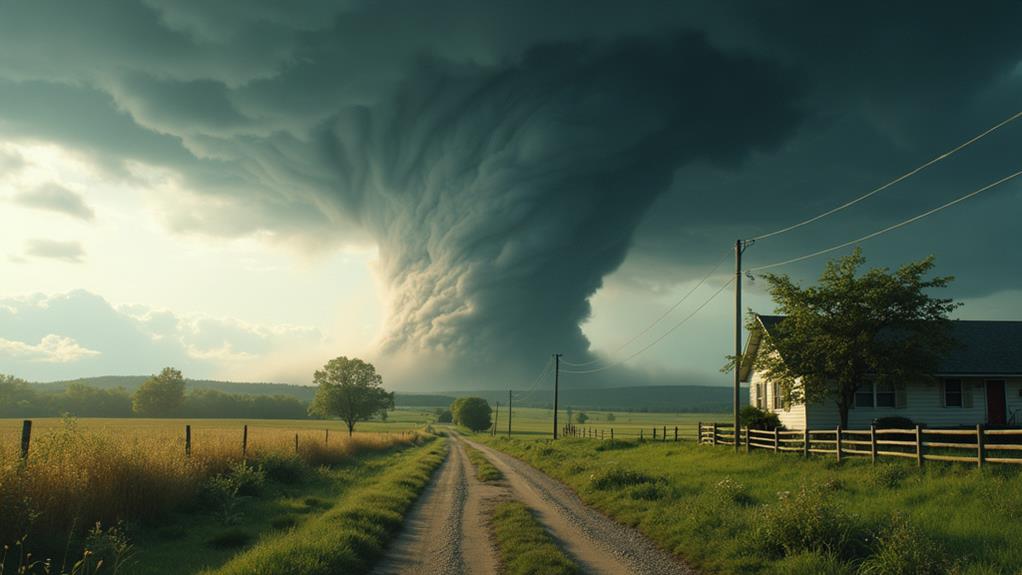
When the skies seem tranquil, it's easy to overlook the significance of tornado safety, but being prepared can save lives. Tornadoes can form unexpectedly, even during calm weather, so you should always monitor weather forecasts and alerts, especially during tornado season. Developing a robust safety plan and practicing it with your family can make a substantial difference when a tornado WARNING is issued.
Here are some crucial steps to guarantee you're prepared:
- Identify a Safe Location: Choose a basement or an interior room without windows for shelter during violent tornadoes.
- Use a NOAA Weather Radio: This device provides timely alerts and updates, making certain you're aware of any imminent danger.
- Practice Drills: Regularly rehearse your safety plan with family members to reduce panic and confusion during an actual event.
- Know the Signs: Stay informed about damage indicators like dark skies, a loud roar, and rotating clouds, especially during thunderstorms.
Frequently Asked Questions
Do Tornadoes Have a Calm Before the Storm?
Yes, tornadoes can have a calm before the storm. You'll often notice calm winds and a pressure drop as the storm approaches. This calm period results from atmospheric instability, where warm, moist air meets cooler air, creating a significant temperature contrast. High moisture levels and wind shear contribute to storm formation. So, while the calm itself doesn't cause tornadoes, it indicates that severe weather, including tornadoes, might be imminent.
What Triggers Tornadoes?
To understand what triggers tornadoes, you need to look at tornado formation. Key factors include atmospheric instability, where warm, moist air meets cooler, dry air. Wind shear plays a vital role by creating rotating columns of air. Temperature contrast and moisture levels further contribute to convective activity. Supercell development, often along cold fronts, is fundamental, providing the structured environment for tornadoes to form.
What Makes a Place Prone to Tornadoes?
You notice tornado hotspots in areas with specific geographical features. Seasonal patterns play a huge role, as does atmospheric instability. High humidity levels near the surface mix with cooler air aloft, creating the perfect storm. Wind shear is essential, too, enhancing the potential for tornado formation. Historical data shows that regions like Tornado Alley are particularly prone due to these combined factors. Understanding these elements helps explain why some places face more tornadoes.
What Conditions Make Tornadoes Most Likely to Happen?
Imagine the sky darkening ominously, and you wonder if a tornado is brewing. Tornado formation factors include atmospheric instability, where warm, moist air meets cooler, dry air. Wind shear variations play a vital role, enhancing rotation. Temperature differences and moisture levels set the stage. Seasonal patterns and geographical influences also dictate when and where tornadoes strike. Stay alert, as these conditions can quickly escalate into a tornado's fury.

